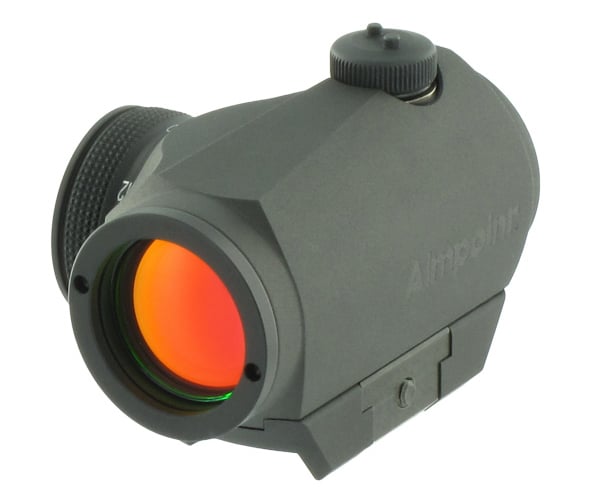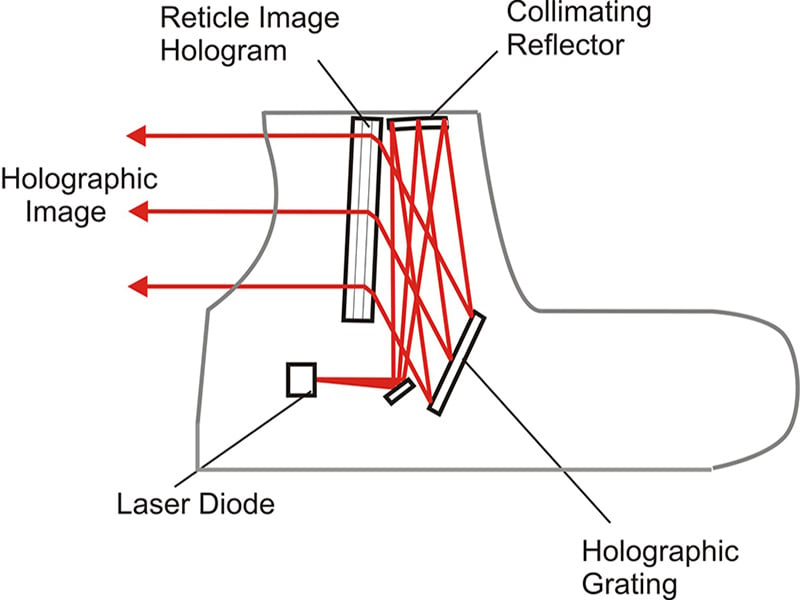
Last Updated on
By David Link
You’ve seen the terms thrown around on websites and in shooting catalogs, but what exactly is the difference between a reflex sight and a holographic sight? Things can get even more complicated when you add the term red dot sight into the mix, but the story is easy to get straight once you figure out which device came first. The concept of the reflex sight (casually referred to as a red dot sight at times) has been around for over 100 years in some regard, and a holographic sight is a more technologically advanced device that has only been around for 20 years or so. Both devices are designed to overcome the shortcomings of iron sights including faster target acquisition and better awareness for the shooter while they are aiming. What these devices don’t do is offer any magnification, therefore they are 1x devices and not the same as Advanced Combat Optical Gunsights. Let’s delve a bit deeper into what makes each device distinct and how these devices came to be.
History And Function Of The Reflex Sight
Irish optics designer Howard Grubb is credited with the concept of the reflector sight way back in 1900. His invention utilized ambient light from a window that sat on the top of the device, and a crosshair was etched in the middle of the glass window. As light bounces off a reflector at the rear of the sight, it is imposed upon the concave glass at the front of the sight. This concave glass is visible to the shooter, and the crosshair from the top window is imposed on this concave surface for targeting purposes. As it was perfected, Grubb’s device drew increased attention from various military designers, and by WWII the reflex sight was being used in a wide variety of aircraft and large and small arms. The term “reflex sight” developed as an abbreviation for reflector sight around this time.

The reflex design produced a wealth of advantages over iron sights, and none is bigger than the ability to make close to medium range targeting easier for shooters of all skill levels. The device is used with both eyes open instead of one eye closed like iron sights, and the shooter leans their dominant eye over the glass portion of the sight. The reticle of the sight can be viewed at any reasonable distance, and it does not require a set eye relief aiding in faster recognition of the reticle without fear of scope eye. The two eyes open aiming scheme also allows for the shooter to keep better stock of their surroundings while still aiming. This can be especially critical in military, self-defense and some competition shooting scenarios.
Over the years, reflex sights have evolved and they have primarily traded ambient light for electrical power sources. The most popular method utilizes battery power, and Aimpoint was the first to unveil an electronic reflex sight in 1975. Although early designs were not very battery efficient, modern devices have superior run times that even allows them to continuously function for years at a time. The advent of electric power also gave reflex sights (and the later holographic sights) the ability to view the reticle even in low light conditions. Many reflex and holographic sights also still display their reticles even when aimed at a bright light source. Reflex sights come in two designs: tube and heads up display (HUD) styles. Tube styles have a lower profile than their larger HUD counterparts, but they sacrifice the larger field of view that can be important in fast target acquisition. HUD style sights are bulkier, but their superior field of view is more on target with their original purpose.

The Difference That Holographic Sights Make
Holographic sights are relative new comers on the targeting scene when compared to reflex sights, and they are the product of several technological advances from the 1950s to the 1990s. The holographic sight is made possible by two main concepts: Synthetic Radar and holography. The first, Synthetic Radar, was developed in the late 1950s to replace early radar techniques. Synthetic radar utilizes invisible microwaves to form a picture of whatever is being targeted. The second, holography, has enjoyed numerous depictions in sci-fi movies over the years as a hologram. Basically a hologram is a three-dimensional image that depicts an object by recording how light interacts with the object. This allows anyone viewing a hologram to see how it appears in real life from all angles. It soon become apparent that both technologies were based on similar properties, and new advances in lasers allowed the scanning required for holography to make holograms possible. The technology was developed for military applications, and as lasers and power sources shrank, the holographic sight for small arms became a reality. The company EOTech was the first to offer the holographic sight for the civilian market in 1996.

Holographic sights are superior to reflex sights because they do not superimpose the reticle onto glass by reflecting it. Instead the holographic sight displays the reticle in 3D space directly in front of the shooter. The viewfinder is not curved like a reflex sight but rather flat which decreases the chances of glare in brighter environments. Such flexibility also allows for windage and elevation adjustments that reflex sights cannot provide. Holographic sights are almost complete resistant to parallax distortion, and the reticle of a holographic sight stays in alignment with the weapon barrel even when it is viewed at an angle. This prevents the likelihood of a shot missing its mark when the shooter doesn’t have much time to aim. Finally, the flexibility of the hologram design allows for a wide variety of reticle types whereas the reflex sight design only allows for limited types.

What To Choose
To be frank, you’ll find the performance of a holographic sight to be superior to that of a reflex sight, but you’ll pay for that difference. Remember that holographic sights are meant for combat situations, and that includes reliable resistances to water and dust. The targeting accuracy of holographic sights is another reason to choose these more advanced devices, especially if pinpoint accuracy is very important to you. As for reflex sights, there are a wide range of models available in these devices, both entry level and top tier. You’ll generally get what you pay for, and don’t expect a cheap red dot to perform the same as a more sophisticated model.




Comments (0)
Rifle Scope Or Red Dot? Which To Choose | The Blog of the Gritr Sports Storesays:
April 15, 2015 at 1:19 pm[…] on the same basic concept, but they are more sophisticated. For a detailed examination check out: How Do Reflex Sights And Holographic Sights Differ? They come in both tube and window configurations, and they mount in the same basic places that you […]